KLK Calling PTZ – The Red Orchestra
KLK Calling PTZ – The Red Orchestra[2] (alternate title: KLK To PTX - The Red Band;[3] German: KLK an PTX – Die Rote Kapelle) is a 1971 East German film about the history of the Red Orchestra espionage ring.
| KLK an PTX – Die Rote Kapelle | |
|---|---|
 Greta Kuckhoff, former member of the Red Orchestra, and actress Barbara Adolph who played her in the film, during the premiere of KLK an PTX. 25 March 1971. | |
| Directed by | Horst E. Brandt |
| Produced by | Heinz Herrmann, Wolfgang Rennebarth |
| Written by | Wera and Claus Küchenmeister |
| Starring | Horst Drinda, Irma Münch, Horst Schulze |
| Music by | Helmut Nier |
| Cinematography | Günter Haubold |
| Edited by | Erika Lehmphul |
Production company | |
| Distributed by | PROGRESS-Film Verleih |
Release date | 25 March 1971 |
Running time | 101 minutes |
| Country | East Germany |
| Language | German |
| Budget | 6,600,000 East German Mark[1] |
Plot
After Hitler's rise to power in 1933, a group of regime opponents from various backgrounds consolidated under the leadership of Harro Schulze-Boysen and Arvid Harnack. They gather intelligence and pass it on to other countries. After the outbreak of the Second World War, and especially after the German invasion of the Soviet Union, they intensify their work. In August 1942, the Gestapo arrests Boysen and soon after cracks down on the spy ring.
Cast
- Horst Drinda: Arvid Harnack
- Irma Münch: Mildred Harnack
- Horst Schulze: Adam Kuckhoff
- Barbara Adolph: Greta Kuckhoff
- Klaus Piontek: Harro Schulze-Boysen
- Jutta Wachowiak: Libertas Schulze-Boysen
- Harry Pietzsch: Walter Küchenmeister
- Karin Lesch: Dr Elfriede Paul
- Marylu Poolman: Elisabeth Schumacher
- Eberhard Esche: Kurt Schumacher
- Katharina Lind: Oda Schottmüller
- Günther Simon: John Sieg
- Jessy Rameik: Sophie Sieg
- Ursula Karusseit: Hilde Coppi
- Manfred Karge: Hans Coppi
- Leon Niemczyk: Vincente Douglas
- Siegfried Weiss: Wilhelm Canaris
- Alfred Müller: Wolfgang Langhoff
- Hannjo Hasse: guest in the American Embassy
- Alfred Struwe: Bellini
- Peter Sturm: Krapotschkin
- Horst Giese: Schröder
Production
Writer Claus Küchenmeister and his wife Wera began conducting interviews with former members of the Red Orchestra during 1966. Claus, son of the executed organization member Walter Küchenmeister, intended to make a documentary about the activities of his father. When officials in the Ministry of State Security's Department of Agitation heard of his project, he was granted full government support and access to previously undisclosed materials in the Ministry's archives. Rather than documentary, a full-length feature film was commissioned.[4]
Reception
KLK Calling PTZ was distributed in fifty-eight copies,[5] and sold 2,107,093 tickets in the first year after its release.[6]
On 4 October 1971, director Horst E. Brandt, cinematographer Günter Haubold and the Küchenmeister couple were awarded the National Prize 1st class for their work on the film.[7] They, dramatist Anne Pfeuffer and actors Horst Drinda, Irma Münch, Horst Schulze, Klaus Piontek, Barbara Adolph, Jutta Wachowiak, Manfred Karge, Ursula Karusseit, Harry Pietzsch, Eberhard Esche and Günther Simon were all granted the Art Prize of the Free German Trade Union Federation in the same year.[3]
Daniela Bergahn noted that, while the film still "inflated" the role of the communists in the resistance to the Nazis, it "at least acknowledged" the participation of other groups.[5] In 1972, the West German story version was disseminated in the television mini series "Die rote Kapelle".
References
- KLK TO PTX - THE RED BAND. Archived 2012-06-04 at the Wayback Machine progress-film.de.
- KLK Calling PTZ – The Red Orchestra at the Internet Movie Database
- KLK an PTX - Die Rote Kapelle. defa.de.
- Johannes Tuchel. Der vergessene Widerstand. Zu Realgeschichte und Wahrnehmung des Kampfes gegen die NS-Diktatur. Wallstein (2001). ISBN 978-3-89244-943-0. Page 263.
- Daniela Berghahn. Hollywood Behind the Wall: the Cinema of East Germany. ISBN 978-0-7190-6172-1. Pages 80, 97.
- Joshua Feinstein. The Triumph of the Ordinary: Depictions of Daily Life in the East German Cinema, 1949-1989. ISBN 978-0-8078-5385-6. Page 289.
- DEFA chronicle of 1971.
External links
- KLK Calling PTZ - The Red Orchestra on the IMDb.